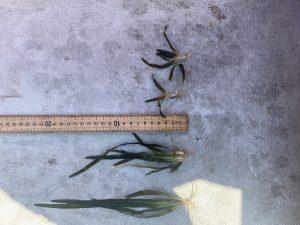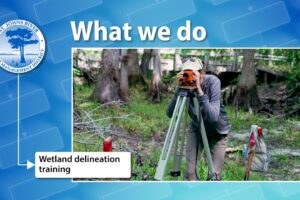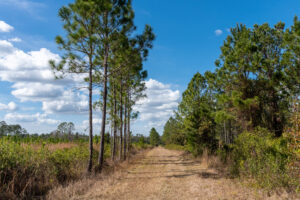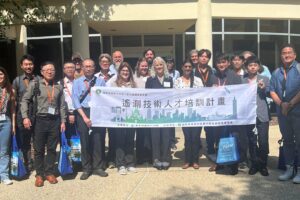Collaborations drive efforts to restore the Lower St. Johns River

Majestic cypress trees line a section of the lower St. Johns River near Jacksonville.
The Lower St. Johns River, which stretches from Lake George to Mayport, is an important natural resource for Florida’s environment and economy. Known for its recreational opportunities—boating, fishing and scenic views—the river also serves as an estuary with habitat for a wide variety of fish and wildlife. However, this part of the river faces growing challenges from pollution and environmental changes that threaten its health and the submerged aquatic vegetation (SAV) that grows in its waters. The District, in collaboration with its partners, is leading efforts to protect and restore the river, ensuring its future health.
One of the biggest challenges in the Lower St. Johns River Basin—which includes all or portions of Nassau, Duval, Baker, Clay, St. Johns, Putnam, Flagler and Volusia counties—is balancing the needs of a growing population while preserving the river’s natural resources. SAV is a key component of this balance; these underwater plants stabilize sediments, improve water quality and provide habitat for fish and other aquatic species. However, the growth of SAV in the Lower St. Johns River has been hindered by several factors, most notably reduced light penetration in the water.
Since Hurricane Irma in 2017, water levels in the river have remained higher than normal, limiting the sunlight that can reach SAV beds. Additionally, flooding in surrounding floodplain wetlands releases organic material into the river, similar to a steeping teabag. This tea-colored water reduces water clarity and reduces sunlight from reaching SAV, slowing its growth.

District staff measure and compare eelgrass, a type of submerged aquatic vegetation, from two different locations in the lower St. Johns River.
Despite these challenges, long-term monitoring by the District has shown that SAV plants continue to grow in many areas, though they are smaller and less dense than before. Turtles, crabs, fish and manatees continue to graze on the SAV, eating faster than the SAV can grow under low-light conditions. Experiments by the District and Florida Fish and Wildlife Conservation Commission (FWC) have shown that when grazers are excluded from an area, the SAV will grow up into the water column, resembling the SAV beds previously found along the river. While this grazing makes the SAV harder for us to see, it hasn’t disappeared. Fortunately, SAV can recover quickly, especially during drier periods when water levels drop, the tea color diminishes, and more sunlight can reach the plants.
Nutrient pollution poses a significant challenge to the Lower St. Johns River. Runoff from farms, treated wastewater and urban stormwater introduces excess nitrogen and phosphorus into the water, fueling algae growth. When these nutrients are in excess, they act like fertilizer for algae, leading to blooms that can produce harmful toxins and deplete oxygen levels, endangering aquatic life. Reducing nutrient pollution is critical to restoring the river’s health. Over the past seven years, the District and its partners have successfully removed more than 600,000 pounds of nitrogen and nearly 200,000 pounds of phosphorus annually through targeted projects. These efforts include addressing septic system pollution, improving stormwater management and encouraging best management practices in agriculture.
Collaboration remains central to restoring the river. The District and its partners have undertaken numerous projects across the region, investing more than $100 million in recent years to protect and enhance water resources. Efforts continue with the North Florida Land Trust (NFLT), which, with support from Rep. Bobby Pane, secured $2 million to restore 150 acres of SAV in the Lower St. Johns River. The District will collaborate with NFLT and FWC to identify restoration sites and monitor progress. Partnerships like these are key to accelerating SAV recovery and improving the river’s long-term health.
While progress is being made, restoring the river’s ecosystem remains a long-term endeavor. Reducing nutrient pollution is essential for preventing harmful algae blooms, but other factors—such as water depth and color—will continue to pose challenges to SAV growth.
Restoring and preserving the Lower St. Johns River is a priority for District and it remains committed to working with its partners and interested stakeholders to use science-based solutions to address the river’s challenges. Through continued investment, research and collaboration, the Lower St. Johns River will continue its recovery, ensuring its vitality for generations to come.





